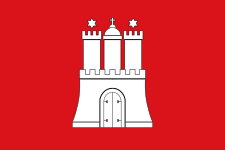Hammonia

Hammonia is the Latin name for Hamburg, and for Hamburg's patron goddess.
The figure of Hammonia as patron goddess of Hamburg first appears in art and literature in the 18th century. Up until the Protestant Reformation, the city's patroness had been the Virgin Mary.
Hammonia is a tall and beautiful goddess who watches over Hamburg. She is usually shown wearing a crown in the form of a city wall surmounted by towers; she may also hold the city's coat of arms, a ship's anchor, etc. She is said to represent the values of Hamburg: freedom, peace, tolerance, prosperity, harmony, welfare and free trade.
Hammonia in art
Hammonia in literature and music
Hamburg’s Anthem, the Hamburg-Lied or Hamburg-Hymne was written in 1828 by Georg Nikolaus Bärmann. Deutschland: Ein Wintermärchen (Germany: A Winter’s Tale) by Heinrich Heine includes her. The goddess is in Heines encounter the fat, tipsy and sentimental daughter of Charlemagne and a "haddock queen". Hammonia also figures large in Wolf Biermann's Deutschland Ein Wintermaerchen.
Hammonia in sculpture

On 10 July 1878 the Hanseatic Building Society unveiled the 17m tall Hansa-Fountain (Hansa-Brunnen) at Hansaplatz in St. Georg as a present to the City of Hamburg. The fountain was designed by architects Heinrich Joseph Kayser and Karl von Großheim, the statue of Hammonia (including minor statues of Archbishop Ansgar, Adolf III of Holstein and Schauenburg, plus the Emperors Constantine and Charlemagne) were created by German sculptor Engelbert Peiffer.
In 1888 a Hammonia statue and that of a young Germania were raised on the Brook’s Bridge (Brooksbrücke) to welcome Emperor Wilhelm II as he opened the Hamburg's Free Port. Shortly after the end of World War II, both statues disappeared without a trace. It took almost 60 years for the city to see the return of their patron goddess: since 2003 a new statue of Hammonia has overlooked the port, and this time she is accompanied by Europa. Both sculptures were created in 2003 by German sculptor Jörg Plickat.
Ships named Hammonia
Hammonia was also the name of a series of 5 ocean-going vessels owned by the Hamburg-American Line, a predecessor of the modern Hapag-Lloyd. The ships were built in 1854, 1867, 1881, 1909, and 1965. The fifth ship, a freighter, is still in service. Several of the earlier ships carried trans-atlantic passengers and played a role in German immigration to the United States.
See also
- Flag and Coat of Arms of Hamburg
- Germania, national personification of Germany
- Deutscher Michel, personification of German people
- Berolina, personification of Berlin
- Bavaria, personification of the Land of Bavaria
External links
| Wikimedia Commons has media related to Hammonia. |
- The Statue of Hammonia
- Heinrich Heine: Deutschland. Ein Wintermärchen
- Photo of the second Hammonia vessel
- History of the Hamburg-America Line including the 5 Hammonia vessels
| ||||||||||||||||||||||||||
